
Nitheesh NH
https://youtu.be/DDuT1mu5hiw
Introduction
IoT includes in one integrated structure the technologies that contribute to the digitalization of retail and is transforming retail by connecting in-store technology to improve operations, increase customer engagement and enhance the shopping experience. IoT is likely to play an increasingly important role in retail as the technology improves and its applications become more efficient.
This report starts with an illustration of IoT architecture in retail, shows how the technology is transforming in-store customer journeys and retail operations, describes how different retailers are integrating IoT networks into their operations and provides an outlook on expected developments in IoT in retail.
IoT Architecture in Retail
IoT describes a network of connected devices capable of collecting and sharing data about their working status with other objects within and outside the network. The data flowing through the system is used by analytics platforms to examine the information and formulate actions for the devices to execute. The structure should normally function with no or minimal human intervention. Figure 1 shows a simple example how IoT could be used in retail.
[caption id="attachment_92891" align="aligncenter" width="700"] Source: Coresight Research[/caption]
IoT architectures integrate several technologies deployed in-store — including sensors, cameras, WiFi, beacons, radio frequency identification (RFID), near field communication (NFC), artificial intelligence (AI), machine learning and autonomous mobile devices.
Transforming the Shopping Journey
IoT gives retailers tools to deepen engagement with the shopper in-store and to transform the customer journey. Below, we illustrate an IoT-powered shopping journey:
[caption id="attachment_92835" align="aligncenter" width="720"]
Source: Coresight Research[/caption]
IoT architectures integrate several technologies deployed in-store — including sensors, cameras, WiFi, beacons, radio frequency identification (RFID), near field communication (NFC), artificial intelligence (AI), machine learning and autonomous mobile devices.
Transforming the Shopping Journey
IoT gives retailers tools to deepen engagement with the shopper in-store and to transform the customer journey. Below, we illustrate an IoT-powered shopping journey:
[caption id="attachment_92835" align="aligncenter" width="720"]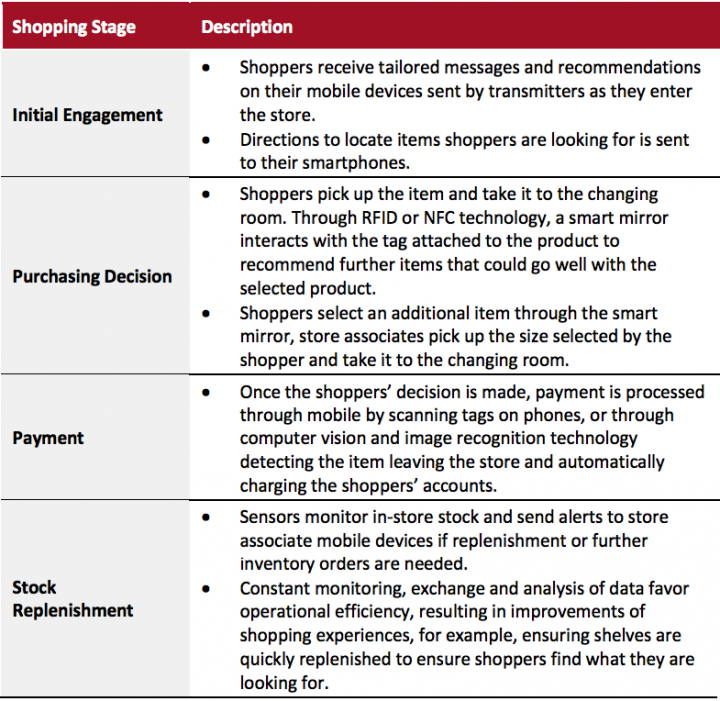 Source: Coresight Research[/caption]
Transforming Retail Operations
IoT architectures can transform retail operations, including:
[caption id="attachment_92836" align="aligncenter" width="720"]
Source: Coresight Research[/caption]
Transforming Retail Operations
IoT architectures can transform retail operations, including:
[caption id="attachment_92836" align="aligncenter" width="720"]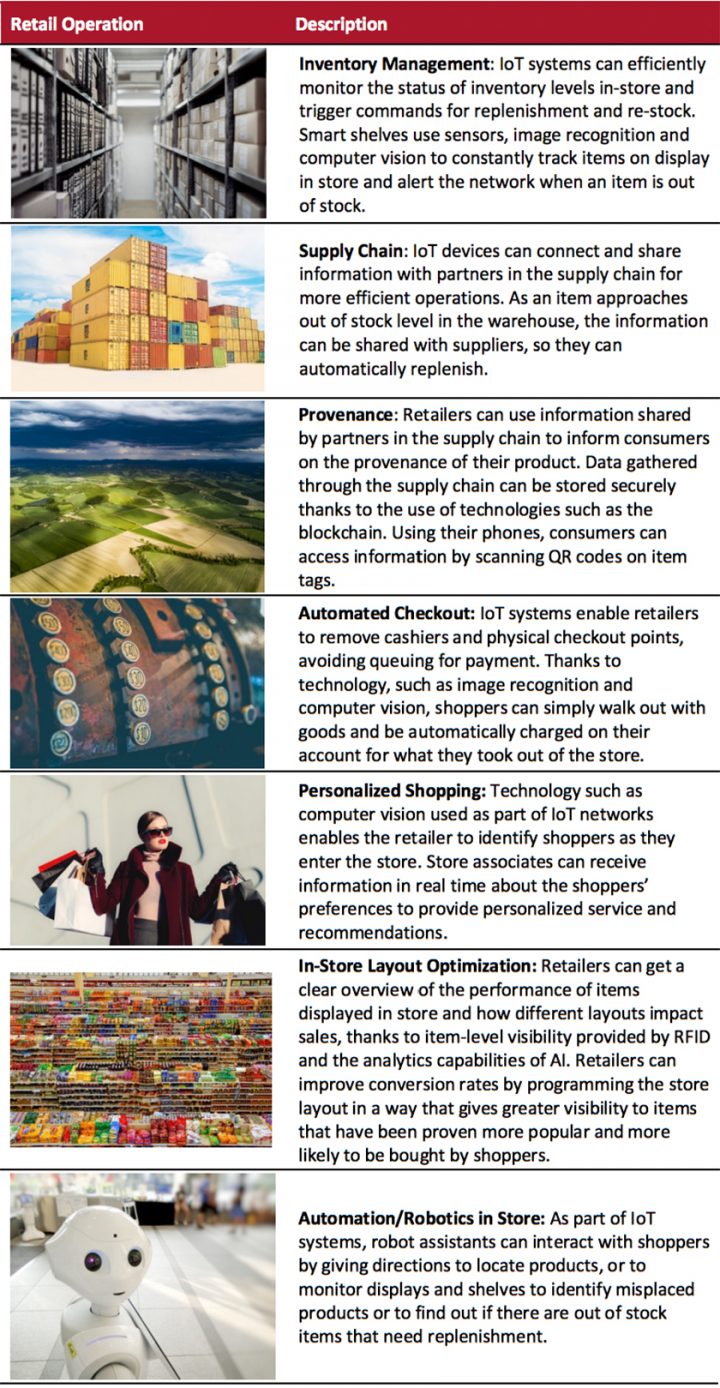 Image Source: Unsplash.com
Image Source: Unsplash.com
Source: Coresight Research[/caption] The adoption of IoT architectures in retail organizations should bring greater operational efficiency, thanks to real-time data gathering and analysis that provides a constant overview of operations and the insight needed to take actions to reduce inventory error. Greater operational efficiency should translate into lower labor costs and growing sales conversions. IoT Adoption Strategies in Retail Retailers can adopt IoT systems by developing the platform themselves - or by working with external providers. Companies that possess the technical skills and resources to develop IoT infrastructure in-house can do so for a variety of reasons, such as the need for a fully customized system, the concern about sharing data with third-party providers, or the possibility of generating a new revenue stream by becoming a provider of IoT systems for other companies. Figure 2 shows the number of patent applications among selected companies in the 12 month period ending June 14, 2019. [caption id="attachment_92837" align="aligncenter" width="720"]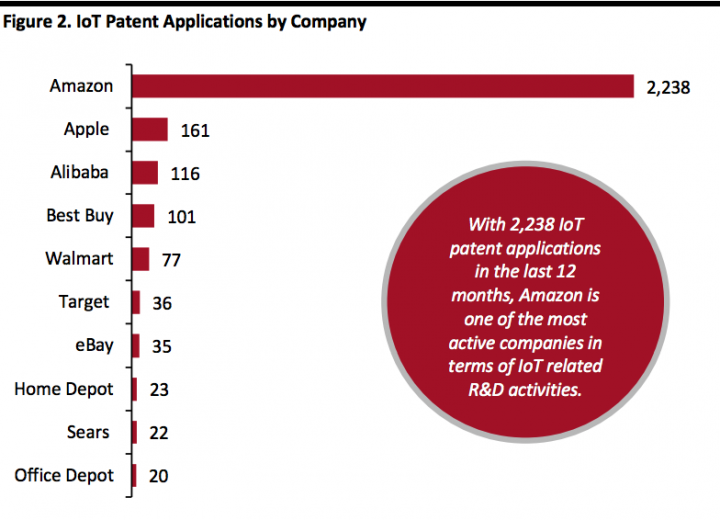 IoT patent applications by company in the 12 months period ending June 14, 2019.
IoT patent applications by company in the 12 months period ending June 14, 2019.
Source: Grata Data[/caption] We can group companies that develop IoT platforms in-house into two main categories: Source: Strategy Analytics[/caption]
Investment in IoT companies is an alternative to developing in-house platforms, which could be a better use of internal resources than seeking to develop these capabilities in-house – and we’re seeing increased investment in these companies.
[caption id="attachment_92839" align="aligncenter" width="720"]
Source: Strategy Analytics[/caption]
Investment in IoT companies is an alternative to developing in-house platforms, which could be a better use of internal resources than seeking to develop these capabilities in-house – and we’re seeing increased investment in these companies.
[caption id="attachment_92839" align="aligncenter" width="720"]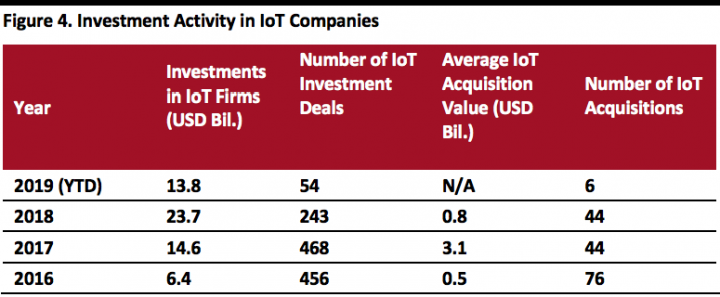 YTD runs to June 21, 2019
YTD runs to June 21, 2019
Source: Index by TNW[/caption] Investment in IoT companies grew to $23.7 billion in 2018, an increase of 270% from 2016, and the pace continues: Investment in IoT firms in the first six months of 2019 has already come close to total investment value for all of 2017. Technology firms with retail operations and large legacy retailers tend to adopt a hybrid strategy focused on in-house R&D and acquisition of external technology providers. Other companies might simply prefer to collaborate with technology firms and startups that specialize in developing IoT systems for retailers. Examples of notable M&A activity include Amazon’s acquisition of Wi-Fi system and beacon manufacturer Eero for $97 million in 2019, and of smart doorbell and camera maker Ring for $1 billion in 2018. These two deals helped strengthen Amazon’s smart home segment. [caption id="attachment_92840" align="aligncenter" width="720"] A smart home system with Amazon Alexa and Eero wifi router
A smart home system with Amazon Alexa and Eero wifi router
Source: Eero[/caption] Collaboration with Retail-Tech Startups for IoT Adoption Working with technology companies and startups that provide IoT platforms is often the best option. Legacy retailers can quickly and efficiently embed IoT technology into operations by turning to the expertise of technology providers. Below, we list selected examples of innovative technology firms that focus on IoT in retail. Trax: The company provides a retail-focused IoT platform that uses computer vision, image recognition and robotics to track products in store by capturing images of how items are displayed on shelves and turning this into data that informs the Trax analytics platform, enabling retailers to enhance operational efficiency in-store and brands to improve shelf execution. Trax lets retailers monitor and correct out of stock items and misplacement in real time and provides insight to inform product positioning and promotion strategies. [caption id="attachment_92841" align="aligncenter" width="720"]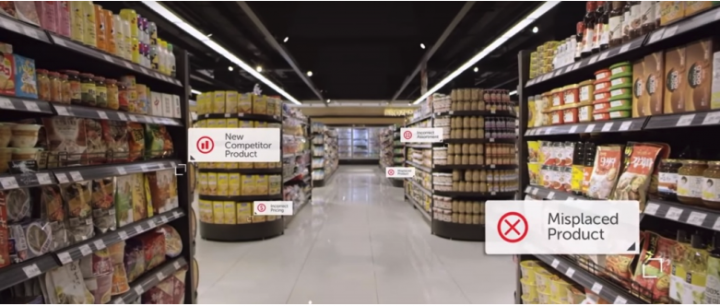 Trax’s analytics enables brands and retailers to monitor in real time products on shelves
Trax’s analytics enables brands and retailers to monitor in real time products on shelves
Source: Trax[/caption] Kwik: The company provides IoT platforms for process automation and data analytics. The company develops sensors that detect when actions are taking place, mining information that is then monitored and analyzed in real-time through the company’s dashboard. Retailers can use the platform to monitor and understand shopper behavior in-store and to measure location-based performance of items on display. [caption id="attachment_92842" align="aligncenter" width="720"]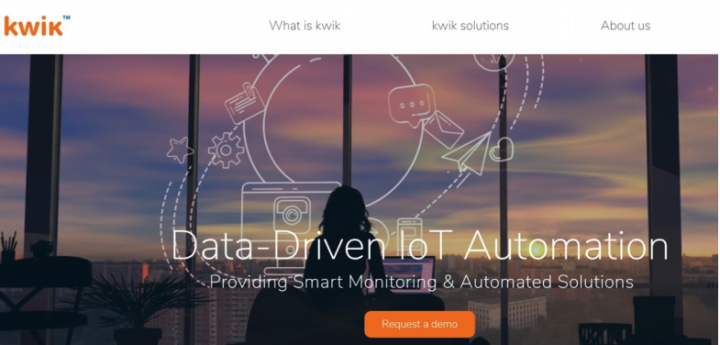 Source: Kwik[/caption]
Evrythng: The company applies IoT technology to track consumer products for traceability, analytics and consumer engagement. The platform enables brands and retailers to obtain data for each item, including supply chain traceability, product provenance and product behavior in store, and to create new forms of customer engagement such as informing about the provenance of an item, providing targeted messages on product use, enabling self-checkout, enabling automatic reorder and enhancing loyalty schemes.
[caption id="attachment_92843" align="aligncenter" width="720"]
Source: Kwik[/caption]
Evrythng: The company applies IoT technology to track consumer products for traceability, analytics and consumer engagement. The platform enables brands and retailers to obtain data for each item, including supply chain traceability, product provenance and product behavior in store, and to create new forms of customer engagement such as informing about the provenance of an item, providing targeted messages on product use, enabling self-checkout, enabling automatic reorder and enhancing loyalty schemes.
[caption id="attachment_92843" align="aligncenter" width="720"]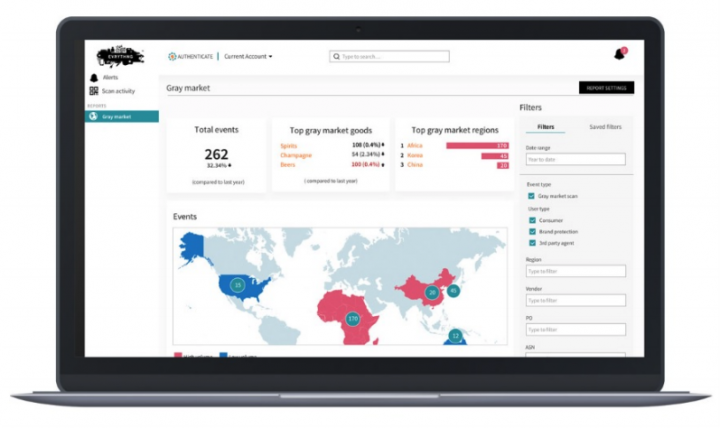 Evrythng’s analytics dashboard
Evrythng’s analytics dashboard
Source: Evrythng[/caption] Caper: The company develops smart shopping carts that use IoT technology to connect with items and the store. Caper’s smart carts use sensors and image recognition to scan items picked up by users and to guide shoppers through the store to help locate products. The carts are also able to recommend products, highlight promotions or deals and lets shoppers self-checkout once the shopping journey is completed. [caption id="attachment_92844" align="aligncenter" width="720"]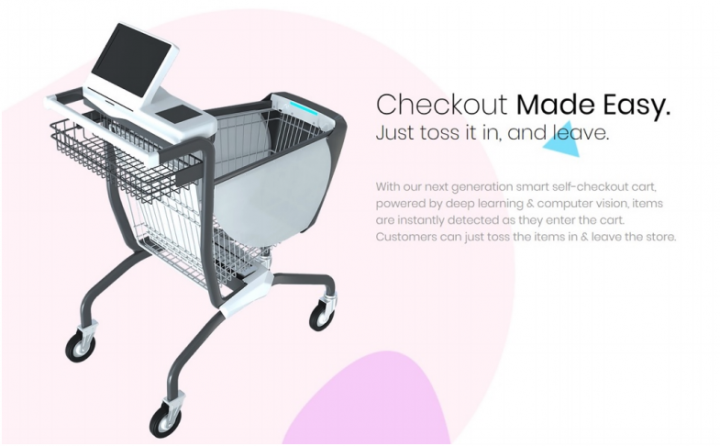 Caper smart cart
Caper smart cart
Source: Caper[/caption] Kontakt: The company developed a platform that uses Beacons and smart tags to transform retail spaces into interactive environments and enable retailers to interact with shoppers in-store, by sending targeted messages related to promotions, deals or product information directly to the shoppers’ mobile devices. Kontakt’s IoT platform also enables retailers to monitor product location, or factors such as temperature, lighting and humidity in store. All information gathered by the IoT system can be visualized on a dashboard that enables users to monitor the store operations in real-time. [caption id="attachment_92845" align="aligncenter" width="720"]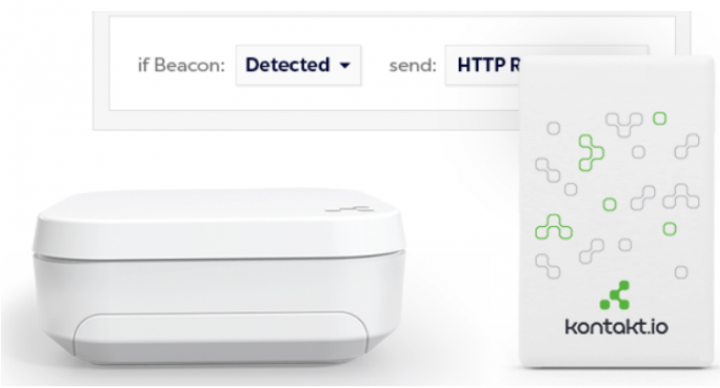 Kontakt’s Beacon
Kontakt’s Beacon
Source: Kontakt[/caption] AWM Smartshelf: The company developed an IoT platform for retail environments that uses displays and optical sensors to monitor on-shelf inventory and to play targeted video messages showing product information tailored to shoppers, taking in demographics or distance from monitors. [caption id="attachment_92846" align="aligncenter" width="720"] Source: AWM Smart Shelf[/caption]
Plexure: The firm provides an IoT-driven customer relationship management platform. Plexure uses information gathered through the platform to improve consumer engagement and maximize conversion. The platform creates a system of smart touchpoints in store that sends targeted messages to shoppers on smartphones based on previous shopping history and on real-time in-store behavior to encourage purchases. In April 2019, food service giant McDonald’s — also a client — bought a $5 million stake in the technology company.
[caption id="attachment_92847" align="aligncenter" width="720"]
Source: AWM Smart Shelf[/caption]
Plexure: The firm provides an IoT-driven customer relationship management platform. Plexure uses information gathered through the platform to improve consumer engagement and maximize conversion. The platform creates a system of smart touchpoints in store that sends targeted messages to shoppers on smartphones based on previous shopping history and on real-time in-store behavior to encourage purchases. In April 2019, food service giant McDonald’s — also a client — bought a $5 million stake in the technology company.
[caption id="attachment_92847" align="aligncenter" width="720"]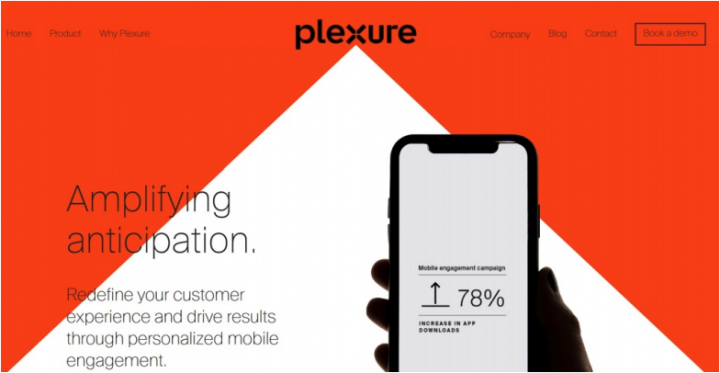 Source: Plexure[/caption]
Future of IoT in Retail: More Secure and Better Connected
We expect IoT to play an increasingly important role in retail in the future as the technologies that compose IoT architectures improve and their applications in retail become more efficient. As a result, the market for connected devices and IoT systems in retail should grow as more companies adopt the platform. Figure 5 shows the market for IoT in retail hardware should increase at an average rate of 16% in the next six years to 2025, according to data firms Statista and Grand View Research.
[caption id="attachment_92848" align="aligncenter" width="720"]
Source: Plexure[/caption]
Future of IoT in Retail: More Secure and Better Connected
We expect IoT to play an increasingly important role in retail in the future as the technologies that compose IoT architectures improve and their applications in retail become more efficient. As a result, the market for connected devices and IoT systems in retail should grow as more companies adopt the platform. Figure 5 shows the market for IoT in retail hardware should increase at an average rate of 16% in the next six years to 2025, according to data firms Statista and Grand View Research.
[caption id="attachment_92848" align="aligncenter" width="720"] Source: Statista/Grand View Research[/caption]
Advancements in technology should contribute to improved efficiency of IoT platforms and expand adoption and applications in retail. In particular, we believe blockchain technology and 5G connectivity could significantly contribute to solving issues that affect IoT systems:
Blockchain: Current IoT systems rely on centralized architectures in which information is sent back and forth from connected devices to the cloud, and could have security and scalability issues. The centralized cloud server creates a single point of failure, which could be targeted by cyberattacks or simply suffer an outage. Because of the need to connect an increasing number of devices as supply chain systems become more advanced, scalability is also a problem. With blockchain technology, IoT systems become decentralized and distributed, removing the presence of a single point of failure, enabling connected devices to work more securely and autonomously and providing greater scalability as additional servers can be added to the distributed network as the system grows. This should allow for greater operational efficiency even with a high number of devices connected. Our report Blockchain in Retail provides an in-depth analysis of the application of the technology in retail.
5G: In brick-and-mortar stores, 5G could enable the implementation of enhanced IoT systems thanks to the faster data transmission and the possibility of connecting a higher number of sensors and devices processing more data, given the greater connection density that the technology allows. In-store shopper engagement could become more intense, with greater customization of the shopping experience due to more effective use of data-heavy facial recognition technology and smart sensors that — with the support of 5G — can detect, react and communicate faster with shoppers based on behavior when browsing the store. Improved communication between connected devices such as AI-powered robots and the surrounding environment could make the deployment of robotics to assist shoppers in-store a common practice. Our report 5G in Retail provides an in-depth analysis of the application of the technology in retail.
We expect the application of blockchain and 5G to substantially improve IoT architectures applied to retail, by enhancing security and scalability and by allowing new applications requiring greater connectivity.
Key Insights
IoT systems connect devices and enable the network to take autonomous actions with no or minimal human intervention. In retail, IoT connects in-store technology to improve operations and to provide a transformed and enhanced shopping experience that increases the retailer’s engagement with the shopper.
With IoT, retail operations become more efficient with improvements in inventory and supply chain management, customized shopping capabilities and in-store layout optimization and with increased automation.
Retailers adopt IoT by developing the technology in-house or by collaborating with external partners and providers. Technology firms with retail operations and large legacy retailers tend to adopt a hybrid strategy focused on in-house R&D and acquisition of external technology providers. The best option for many companies may be collaboration with technology firms and startups that specialize in IoT systems for retailers.
In the future, we expect IoT to play an increasingly important role in retail as the technology improves and its applications in retail become more efficient. The market for connected devices and IoT systems in retail should grow as more companies adopt the technology. Statista and Grand View Research expect the US IoT Hardware market in retail to increase at a 16% CAGR to 2025.
The application of emerging technologies to IoT — including blockchain and 5G — should drastically improve security, connectivity and scalability and significantly encourage further adoption in retail.
Source: Statista/Grand View Research[/caption]
Advancements in technology should contribute to improved efficiency of IoT platforms and expand adoption and applications in retail. In particular, we believe blockchain technology and 5G connectivity could significantly contribute to solving issues that affect IoT systems:
Blockchain: Current IoT systems rely on centralized architectures in which information is sent back and forth from connected devices to the cloud, and could have security and scalability issues. The centralized cloud server creates a single point of failure, which could be targeted by cyberattacks or simply suffer an outage. Because of the need to connect an increasing number of devices as supply chain systems become more advanced, scalability is also a problem. With blockchain technology, IoT systems become decentralized and distributed, removing the presence of a single point of failure, enabling connected devices to work more securely and autonomously and providing greater scalability as additional servers can be added to the distributed network as the system grows. This should allow for greater operational efficiency even with a high number of devices connected. Our report Blockchain in Retail provides an in-depth analysis of the application of the technology in retail.
5G: In brick-and-mortar stores, 5G could enable the implementation of enhanced IoT systems thanks to the faster data transmission and the possibility of connecting a higher number of sensors and devices processing more data, given the greater connection density that the technology allows. In-store shopper engagement could become more intense, with greater customization of the shopping experience due to more effective use of data-heavy facial recognition technology and smart sensors that — with the support of 5G — can detect, react and communicate faster with shoppers based on behavior when browsing the store. Improved communication between connected devices such as AI-powered robots and the surrounding environment could make the deployment of robotics to assist shoppers in-store a common practice. Our report 5G in Retail provides an in-depth analysis of the application of the technology in retail.
We expect the application of blockchain and 5G to substantially improve IoT architectures applied to retail, by enhancing security and scalability and by allowing new applications requiring greater connectivity.
Key Insights
IoT systems connect devices and enable the network to take autonomous actions with no or minimal human intervention. In retail, IoT connects in-store technology to improve operations and to provide a transformed and enhanced shopping experience that increases the retailer’s engagement with the shopper.
With IoT, retail operations become more efficient with improvements in inventory and supply chain management, customized shopping capabilities and in-store layout optimization and with increased automation.
Retailers adopt IoT by developing the technology in-house or by collaborating with external partners and providers. Technology firms with retail operations and large legacy retailers tend to adopt a hybrid strategy focused on in-house R&D and acquisition of external technology providers. The best option for many companies may be collaboration with technology firms and startups that specialize in IoT systems for retailers.
In the future, we expect IoT to play an increasingly important role in retail as the technology improves and its applications in retail become more efficient. The market for connected devices and IoT systems in retail should grow as more companies adopt the technology. Statista and Grand View Research expect the US IoT Hardware market in retail to increase at a 16% CAGR to 2025.
The application of emerging technologies to IoT — including blockchain and 5G — should drastically improve security, connectivity and scalability and significantly encourage further adoption in retail.
 Source: Coresight Research[/caption]
IoT architectures integrate several technologies deployed in-store — including sensors, cameras, WiFi, beacons, radio frequency identification (RFID), near field communication (NFC), artificial intelligence (AI), machine learning and autonomous mobile devices.
Transforming the Shopping Journey
IoT gives retailers tools to deepen engagement with the shopper in-store and to transform the customer journey. Below, we illustrate an IoT-powered shopping journey:
[caption id="attachment_92835" align="aligncenter" width="720"]
Source: Coresight Research[/caption]
IoT architectures integrate several technologies deployed in-store — including sensors, cameras, WiFi, beacons, radio frequency identification (RFID), near field communication (NFC), artificial intelligence (AI), machine learning and autonomous mobile devices.
Transforming the Shopping Journey
IoT gives retailers tools to deepen engagement with the shopper in-store and to transform the customer journey. Below, we illustrate an IoT-powered shopping journey:
[caption id="attachment_92835" align="aligncenter" width="720"] Source: Coresight Research[/caption]
Transforming Retail Operations
IoT architectures can transform retail operations, including:
[caption id="attachment_92836" align="aligncenter" width="720"]
Source: Coresight Research[/caption]
Transforming Retail Operations
IoT architectures can transform retail operations, including:
[caption id="attachment_92836" align="aligncenter" width="720"] Image Source: Unsplash.com
Image Source: Unsplash.comSource: Coresight Research[/caption] The adoption of IoT architectures in retail organizations should bring greater operational efficiency, thanks to real-time data gathering and analysis that provides a constant overview of operations and the insight needed to take actions to reduce inventory error. Greater operational efficiency should translate into lower labor costs and growing sales conversions. IoT Adoption Strategies in Retail Retailers can adopt IoT systems by developing the platform themselves - or by working with external providers. Companies that possess the technical skills and resources to develop IoT infrastructure in-house can do so for a variety of reasons, such as the need for a fully customized system, the concern about sharing data with third-party providers, or the possibility of generating a new revenue stream by becoming a provider of IoT systems for other companies. Figure 2 shows the number of patent applications among selected companies in the 12 month period ending June 14, 2019. [caption id="attachment_92837" align="aligncenter" width="720"]
 IoT patent applications by company in the 12 months period ending June 14, 2019.
IoT patent applications by company in the 12 months period ending June 14, 2019. Source: Grata Data[/caption] We can group companies that develop IoT platforms in-house into two main categories:
- Tech firms: technology companies with born-digital retail operations, such as Amazon, Apple, Alibaba and eBay.
- Legacy retailers: large legacy retailers that develop proprietary technology, including US retail giants Best Buy, Walmart and Target.
 Source: Strategy Analytics[/caption]
Investment in IoT companies is an alternative to developing in-house platforms, which could be a better use of internal resources than seeking to develop these capabilities in-house – and we’re seeing increased investment in these companies.
[caption id="attachment_92839" align="aligncenter" width="720"]
Source: Strategy Analytics[/caption]
Investment in IoT companies is an alternative to developing in-house platforms, which could be a better use of internal resources than seeking to develop these capabilities in-house – and we’re seeing increased investment in these companies.
[caption id="attachment_92839" align="aligncenter" width="720"] YTD runs to June 21, 2019
YTD runs to June 21, 2019Source: Index by TNW[/caption] Investment in IoT companies grew to $23.7 billion in 2018, an increase of 270% from 2016, and the pace continues: Investment in IoT firms in the first six months of 2019 has already come close to total investment value for all of 2017. Technology firms with retail operations and large legacy retailers tend to adopt a hybrid strategy focused on in-house R&D and acquisition of external technology providers. Other companies might simply prefer to collaborate with technology firms and startups that specialize in developing IoT systems for retailers. Examples of notable M&A activity include Amazon’s acquisition of Wi-Fi system and beacon manufacturer Eero for $97 million in 2019, and of smart doorbell and camera maker Ring for $1 billion in 2018. These two deals helped strengthen Amazon’s smart home segment. [caption id="attachment_92840" align="aligncenter" width="720"]
 A smart home system with Amazon Alexa and Eero wifi router
A smart home system with Amazon Alexa and Eero wifi routerSource: Eero[/caption] Collaboration with Retail-Tech Startups for IoT Adoption Working with technology companies and startups that provide IoT platforms is often the best option. Legacy retailers can quickly and efficiently embed IoT technology into operations by turning to the expertise of technology providers. Below, we list selected examples of innovative technology firms that focus on IoT in retail. Trax: The company provides a retail-focused IoT platform that uses computer vision, image recognition and robotics to track products in store by capturing images of how items are displayed on shelves and turning this into data that informs the Trax analytics platform, enabling retailers to enhance operational efficiency in-store and brands to improve shelf execution. Trax lets retailers monitor and correct out of stock items and misplacement in real time and provides insight to inform product positioning and promotion strategies. [caption id="attachment_92841" align="aligncenter" width="720"]
 Trax’s analytics enables brands and retailers to monitor in real time products on shelves
Trax’s analytics enables brands and retailers to monitor in real time products on shelvesSource: Trax[/caption] Kwik: The company provides IoT platforms for process automation and data analytics. The company develops sensors that detect when actions are taking place, mining information that is then monitored and analyzed in real-time through the company’s dashboard. Retailers can use the platform to monitor and understand shopper behavior in-store and to measure location-based performance of items on display. [caption id="attachment_92842" align="aligncenter" width="720"]
 Source: Kwik[/caption]
Evrythng: The company applies IoT technology to track consumer products for traceability, analytics and consumer engagement. The platform enables brands and retailers to obtain data for each item, including supply chain traceability, product provenance and product behavior in store, and to create new forms of customer engagement such as informing about the provenance of an item, providing targeted messages on product use, enabling self-checkout, enabling automatic reorder and enhancing loyalty schemes.
[caption id="attachment_92843" align="aligncenter" width="720"]
Source: Kwik[/caption]
Evrythng: The company applies IoT technology to track consumer products for traceability, analytics and consumer engagement. The platform enables brands and retailers to obtain data for each item, including supply chain traceability, product provenance and product behavior in store, and to create new forms of customer engagement such as informing about the provenance of an item, providing targeted messages on product use, enabling self-checkout, enabling automatic reorder and enhancing loyalty schemes.
[caption id="attachment_92843" align="aligncenter" width="720"] Evrythng’s analytics dashboard
Evrythng’s analytics dashboardSource: Evrythng[/caption] Caper: The company develops smart shopping carts that use IoT technology to connect with items and the store. Caper’s smart carts use sensors and image recognition to scan items picked up by users and to guide shoppers through the store to help locate products. The carts are also able to recommend products, highlight promotions or deals and lets shoppers self-checkout once the shopping journey is completed. [caption id="attachment_92844" align="aligncenter" width="720"]
 Caper smart cart
Caper smart cart Source: Caper[/caption] Kontakt: The company developed a platform that uses Beacons and smart tags to transform retail spaces into interactive environments and enable retailers to interact with shoppers in-store, by sending targeted messages related to promotions, deals or product information directly to the shoppers’ mobile devices. Kontakt’s IoT platform also enables retailers to monitor product location, or factors such as temperature, lighting and humidity in store. All information gathered by the IoT system can be visualized on a dashboard that enables users to monitor the store operations in real-time. [caption id="attachment_92845" align="aligncenter" width="720"]
 Kontakt’s Beacon
Kontakt’s BeaconSource: Kontakt[/caption] AWM Smartshelf: The company developed an IoT platform for retail environments that uses displays and optical sensors to monitor on-shelf inventory and to play targeted video messages showing product information tailored to shoppers, taking in demographics or distance from monitors. [caption id="attachment_92846" align="aligncenter" width="720"]
 Source: AWM Smart Shelf[/caption]
Plexure: The firm provides an IoT-driven customer relationship management platform. Plexure uses information gathered through the platform to improve consumer engagement and maximize conversion. The platform creates a system of smart touchpoints in store that sends targeted messages to shoppers on smartphones based on previous shopping history and on real-time in-store behavior to encourage purchases. In April 2019, food service giant McDonald’s — also a client — bought a $5 million stake in the technology company.
[caption id="attachment_92847" align="aligncenter" width="720"]
Source: AWM Smart Shelf[/caption]
Plexure: The firm provides an IoT-driven customer relationship management platform. Plexure uses information gathered through the platform to improve consumer engagement and maximize conversion. The platform creates a system of smart touchpoints in store that sends targeted messages to shoppers on smartphones based on previous shopping history and on real-time in-store behavior to encourage purchases. In April 2019, food service giant McDonald’s — also a client — bought a $5 million stake in the technology company.
[caption id="attachment_92847" align="aligncenter" width="720"] Source: Plexure[/caption]
Future of IoT in Retail: More Secure and Better Connected
We expect IoT to play an increasingly important role in retail in the future as the technologies that compose IoT architectures improve and their applications in retail become more efficient. As a result, the market for connected devices and IoT systems in retail should grow as more companies adopt the platform. Figure 5 shows the market for IoT in retail hardware should increase at an average rate of 16% in the next six years to 2025, according to data firms Statista and Grand View Research.
[caption id="attachment_92848" align="aligncenter" width="720"]
Source: Plexure[/caption]
Future of IoT in Retail: More Secure and Better Connected
We expect IoT to play an increasingly important role in retail in the future as the technologies that compose IoT architectures improve and their applications in retail become more efficient. As a result, the market for connected devices and IoT systems in retail should grow as more companies adopt the platform. Figure 5 shows the market for IoT in retail hardware should increase at an average rate of 16% in the next six years to 2025, according to data firms Statista and Grand View Research.
[caption id="attachment_92848" align="aligncenter" width="720"] Source: Statista/Grand View Research[/caption]
Advancements in technology should contribute to improved efficiency of IoT platforms and expand adoption and applications in retail. In particular, we believe blockchain technology and 5G connectivity could significantly contribute to solving issues that affect IoT systems:
Blockchain: Current IoT systems rely on centralized architectures in which information is sent back and forth from connected devices to the cloud, and could have security and scalability issues. The centralized cloud server creates a single point of failure, which could be targeted by cyberattacks or simply suffer an outage. Because of the need to connect an increasing number of devices as supply chain systems become more advanced, scalability is also a problem. With blockchain technology, IoT systems become decentralized and distributed, removing the presence of a single point of failure, enabling connected devices to work more securely and autonomously and providing greater scalability as additional servers can be added to the distributed network as the system grows. This should allow for greater operational efficiency even with a high number of devices connected. Our report Blockchain in Retail provides an in-depth analysis of the application of the technology in retail.
5G: In brick-and-mortar stores, 5G could enable the implementation of enhanced IoT systems thanks to the faster data transmission and the possibility of connecting a higher number of sensors and devices processing more data, given the greater connection density that the technology allows. In-store shopper engagement could become more intense, with greater customization of the shopping experience due to more effective use of data-heavy facial recognition technology and smart sensors that — with the support of 5G — can detect, react and communicate faster with shoppers based on behavior when browsing the store. Improved communication between connected devices such as AI-powered robots and the surrounding environment could make the deployment of robotics to assist shoppers in-store a common practice. Our report 5G in Retail provides an in-depth analysis of the application of the technology in retail.
We expect the application of blockchain and 5G to substantially improve IoT architectures applied to retail, by enhancing security and scalability and by allowing new applications requiring greater connectivity.
Key Insights
IoT systems connect devices and enable the network to take autonomous actions with no or minimal human intervention. In retail, IoT connects in-store technology to improve operations and to provide a transformed and enhanced shopping experience that increases the retailer’s engagement with the shopper.
With IoT, retail operations become more efficient with improvements in inventory and supply chain management, customized shopping capabilities and in-store layout optimization and with increased automation.
Retailers adopt IoT by developing the technology in-house or by collaborating with external partners and providers. Technology firms with retail operations and large legacy retailers tend to adopt a hybrid strategy focused on in-house R&D and acquisition of external technology providers. The best option for many companies may be collaboration with technology firms and startups that specialize in IoT systems for retailers.
In the future, we expect IoT to play an increasingly important role in retail as the technology improves and its applications in retail become more efficient. The market for connected devices and IoT systems in retail should grow as more companies adopt the technology. Statista and Grand View Research expect the US IoT Hardware market in retail to increase at a 16% CAGR to 2025.
The application of emerging technologies to IoT — including blockchain and 5G — should drastically improve security, connectivity and scalability and significantly encourage further adoption in retail.
Source: Statista/Grand View Research[/caption]
Advancements in technology should contribute to improved efficiency of IoT platforms and expand adoption and applications in retail. In particular, we believe blockchain technology and 5G connectivity could significantly contribute to solving issues that affect IoT systems:
Blockchain: Current IoT systems rely on centralized architectures in which information is sent back and forth from connected devices to the cloud, and could have security and scalability issues. The centralized cloud server creates a single point of failure, which could be targeted by cyberattacks or simply suffer an outage. Because of the need to connect an increasing number of devices as supply chain systems become more advanced, scalability is also a problem. With blockchain technology, IoT systems become decentralized and distributed, removing the presence of a single point of failure, enabling connected devices to work more securely and autonomously and providing greater scalability as additional servers can be added to the distributed network as the system grows. This should allow for greater operational efficiency even with a high number of devices connected. Our report Blockchain in Retail provides an in-depth analysis of the application of the technology in retail.
5G: In brick-and-mortar stores, 5G could enable the implementation of enhanced IoT systems thanks to the faster data transmission and the possibility of connecting a higher number of sensors and devices processing more data, given the greater connection density that the technology allows. In-store shopper engagement could become more intense, with greater customization of the shopping experience due to more effective use of data-heavy facial recognition technology and smart sensors that — with the support of 5G — can detect, react and communicate faster with shoppers based on behavior when browsing the store. Improved communication between connected devices such as AI-powered robots and the surrounding environment could make the deployment of robotics to assist shoppers in-store a common practice. Our report 5G in Retail provides an in-depth analysis of the application of the technology in retail.
We expect the application of blockchain and 5G to substantially improve IoT architectures applied to retail, by enhancing security and scalability and by allowing new applications requiring greater connectivity.
Key Insights
IoT systems connect devices and enable the network to take autonomous actions with no or minimal human intervention. In retail, IoT connects in-store technology to improve operations and to provide a transformed and enhanced shopping experience that increases the retailer’s engagement with the shopper.
With IoT, retail operations become more efficient with improvements in inventory and supply chain management, customized shopping capabilities and in-store layout optimization and with increased automation.
Retailers adopt IoT by developing the technology in-house or by collaborating with external partners and providers. Technology firms with retail operations and large legacy retailers tend to adopt a hybrid strategy focused on in-house R&D and acquisition of external technology providers. The best option for many companies may be collaboration with technology firms and startups that specialize in IoT systems for retailers.
In the future, we expect IoT to play an increasingly important role in retail as the technology improves and its applications in retail become more efficient. The market for connected devices and IoT systems in retail should grow as more companies adopt the technology. Statista and Grand View Research expect the US IoT Hardware market in retail to increase at a 16% CAGR to 2025.
The application of emerging technologies to IoT — including blockchain and 5G — should drastically improve security, connectivity and scalability and significantly encourage further adoption in retail.